A glimpse into the field
Observation at Holuhraun eruptive site
Sunday 14 September
The plume is rather low and lies close to the ground. Winds are southerly, so that the plume will be carried over the base camp in Dreki. Everyone here will leave camp now and spend the night in Mývatnssveit, says dr. Ármann Höskuldsson, volcanologist at IES:
Baugur and two of his babies are still active. And yet, its force is considerably less today than yesterday. There is one fountain to speak of and it only reaches about 20 til 50 m over the crater's rims. Possibly this explains the low layout of the plume today, perhaps there isn't enough heat convection to lift it.
The lava has not advanced any further at river Jökulsá á Fjöllum, but it has broadened (see map). A central hot patch of the lava gives rise to a stretch to the north, onto Flæður area. Today's measurements show a cover of 3 km² in only two hours. Thermal images reveal a temperature of 1100-1150°C.
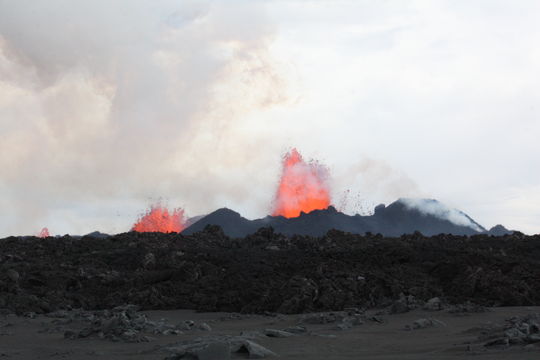
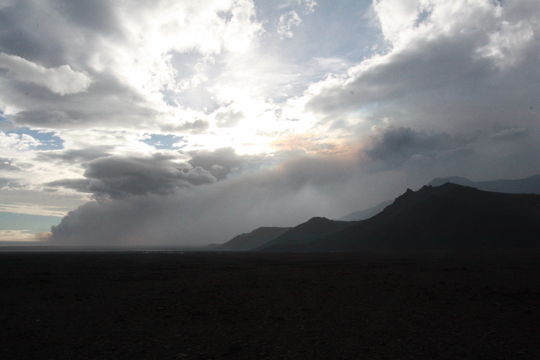
Saturday 13 September
The activity has decreased considerably since yesterday. It is now confined to the centre of the fissure, i.e. craters Baugur and Baugsbörn are active while Suðri has ceased. The lava is progressing much slower than before (see map), it has advanced only ca. 50-100 m since last night into the river, Jökulsá á Fjöllum. However, the edge has broadened somewhat. Ármann Höskuldsson, Institute of Earth Sciences:
Rather windy until noon. Back to the eruptive site just after eleven, to proceed with the measurements. Little changes were seen. The east banks of the river have suffered erosion because of the narrowing of the riverbed, caused by the lava. According to observations, that edge of the lava which has entered the river has not advanced this afternoon.

Crater Suðri had already ceased erupting when we approached the site. Only the central part of the fissure is now active. Baugur is rather mellow with only three fountains. Their maximum height was about 120 m. A geodetic specialist arrived today to measure the height of the craters. Baugur proved to be about 60 m high and its fountains 60 m above that, or around 120 m in total. Baugur's babies are still active and were boiling and murmuring throughout the day.
In general, eruptive activity has diminished and all lava streams are less forceful in their advance. The largest change was 2 km northeast of the eruptive site, where the edges were explored for under- and overbursts. Advancing streams turned out to be at 1100°C with low viscosity. These particular edges have not shown any change for quite some days until now. This supports the idea that when the farthest edges begin to cool and show resistance to advancing, other edges closer to the eruptive site suffer deformation with small lava streams protruding from underneath or above the edge. This is a sign of decreasing activity.
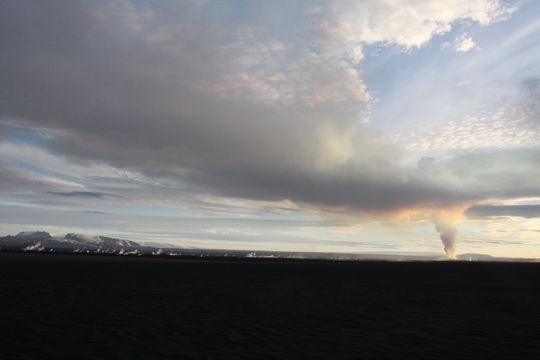
Friday 12 September
Friday 12 September was windy and dusty at the eruptive site. At noon, a brief calm gave some photo opportunity. Ármann Höskuldsson, IES, sent an illustrated account of the situation:
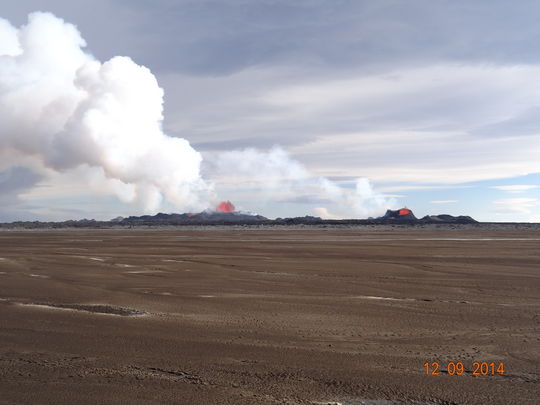
The lava is still advancing in the riverbed of Jökulsá á Fjöllum. A narrow flow with heavy current is between the lava and the eastern wall of the riverbed. Occasionally, small steam explosives occur at the edges. The lava advanced 600 m in the past 24 hours. It is still expanding towards north, away from the path of the river.
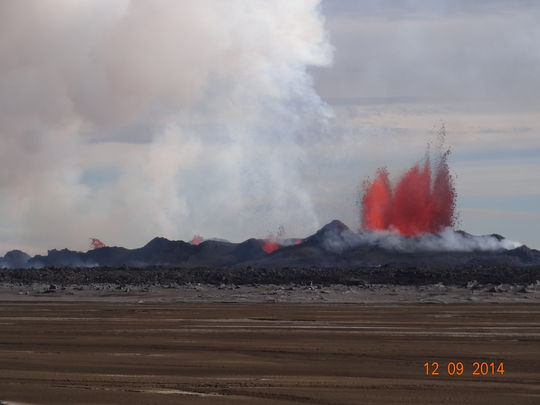
The activity on the fissure is mostly confined to craters Suðri and Baugur. Baugur's activity diminished somewhat towards evening and at 21:00 it had only three fountains whereas this morning it had a solid wall of fire. These are signs of temporary narrowing in the eruptive vent. Baugsbörn (i.e. Baugur's babies, three or four small vents north of Baugur) do have lava lakes that are boiling. Suðri's activity has increased, probably because the position of its rims has changed. Lava flows towards south from Suðri. These changes in the craters on the active part of the fissure are not necessarily indicative of diminishing eruption; it has happened before that the activity dwindles and then rises again.

The gas plume has been continuous and stable today, Friday 12 September; mostly from crater Baugur. Lava fountains from Baugur have been 70-120 m high and this is the only crater still giving rise to fountains.
A new forecast of gas dispersion
Given the dangerous gas levels at the eruptive site which get carried, albeit dispersed, from the highlands down into the deep firths of Eastfjords and their farming grounds and fishing villages; the Icelandic Met Office has begun to issue warnings when necessary. They are found in a yellow ribbon in the header of every web page of en.vedur.is, IMO's web, when relevant. When no warnings are being issued, the yellow ribbon disappears.




